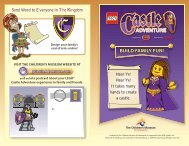Giving Back to Our Community - The Children's Museum of ...
Giving Back to Our Community - The Children's Museum of ...
Giving Back to Our Community - The Children's Museum of ...
You also want an ePaper? Increase the reach of your titles
YUMPU automatically turns print PDFs into web optimized ePapers that Google loves.
MUSEUM COLLECTIONS<br />
Although its acquisition was originally announced a year<br />
earlier, in May 2006 the museum and members <strong>of</strong> its<br />
International Paleon<strong>to</strong>logy Advisory Committee formally<br />
named a new dinosaur genus and species. <strong>The</strong> naming<br />
was timed <strong>to</strong> coincide with the formal presentation <strong>of</strong> a<br />
scientific paper on the specimen at the Current Research<br />
on Late Cretaceous Vertebrates from the Western Interior<br />
Symposium. This unique, one-<strong>of</strong>-a-kind species was put<br />
on public display and <strong>of</strong>ficially given the name Dracorex<br />
hogwartsia, garnering international media attention and<br />
engaging hoards <strong>of</strong> Harry Potter fans.<br />
<strong>The</strong> first part <strong>of</strong> the name, Dracorex, means “Dragon King”<br />
and was chosen because the dinosaur bore a close<br />
resemblance <strong>to</strong> the mythical dragon with its bony head<br />
covered in spikes and knobs. <strong>The</strong> species name hogwartsia<br />
was selected <strong>to</strong> honor the fictional Hogwarts<br />
School <strong>of</strong> Witchcraft and Wizardry, created by children’s<br />
book author J.K. Rowling.<br />
In granting permission <strong>to</strong> name the specimen for her<br />
work, Rowling said,“<strong>The</strong> naming <strong>of</strong> Dracorex hogwartsia is<br />
easily the most unexpected honor <strong>to</strong> have come my way<br />
since the publication <strong>of</strong> the Harry Potter books!”<br />
Dracorex is a member <strong>of</strong> the Pachycephalosaur family,<br />
commonly referred <strong>to</strong> as “boneheads.” This group <strong>of</strong><br />
antelope-sized dinosaurs lived over 66 million years ago<br />
during the Cretaceous Period.<br />
“This fossil is a scientifically significant miles<strong>to</strong>ne in the<br />
world <strong>of</strong> paleon<strong>to</strong>logy,” wrote Dr. Robert Bakker, an internationally<br />
renowned paleon<strong>to</strong>logist. “It proves that<br />
family trees were still branching <strong>of</strong>f and evolving, even<br />
near the end <strong>of</strong> the age <strong>of</strong> dinosaurs.”<br />
Steve Saulsbury, Patrick Saulsbury and Brian Buckmeier,<br />
all from Sioux City, Iowa, donated the nearly complete<br />
Pachycephalosaur skull <strong>to</strong> <strong>The</strong> Children’s <strong>Museum</strong>. After a<br />
summer presentation on Level 2, Dracorex moved <strong>to</strong> its<br />
permanent home in Dinosphere. ®<br />
▼<br />
▼<br />
2006.75.1<br />
Late Cretaceous dinosaur<br />
Dracorex hogwartsia<br />
Cast body<br />
Harding Co., South Dakota<br />
Internationally renowned paleon<strong>to</strong>logist Dr. Robert<br />
Bakker discusses the importance <strong>of</strong> Dracorex hogwartsia<br />
<strong>to</strong> science.<br />
ANNUAL REPORT 2006 THE CHILDREN’S MUSEUM OF INDIANAPOLIS<br />
21





